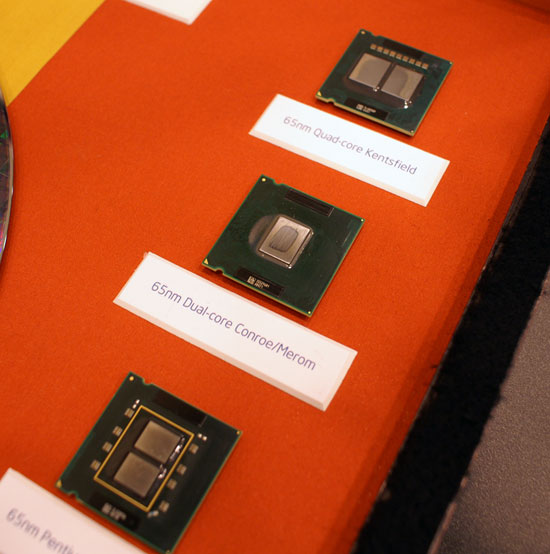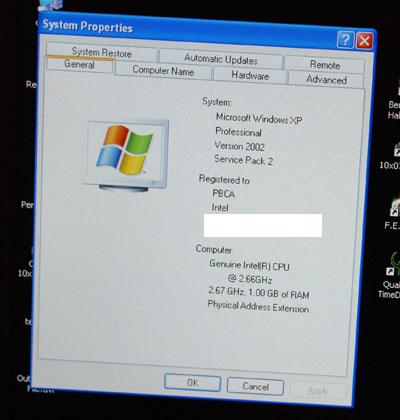Spring IDF 2006 Conroe Preview: Intel Regains the Performance Crown
by Anand Lal Shimpi on March 7, 2006 3:58 PM EST- Posted in
- Trade Shows
Intel is very excited about its new Core architecture, especially with Conroe on the desktop. It's not really news to anyone that Intel hasn't had the desktop performance crown for years now; its Pentium 4 and Pentium D processors run hotter and offer competitive or lower performance than their AMD competitors. With Conroe, Intel hopes to change all of that.

From top to bottom - Quad-core 65nm Kentsfield, dual core 65nm Conroe and 65nm Pentium D
Intel setup two identical systems: in one corner, an Athlon 64 FX-60 overclocked to 2.8GHz running on a DFI RD480 motherboard. And in the other corner, a Conroe running at 2.66GHz (1067MHz FSB) on an Intel 975X motherboard.


The AMD system used 1GB of DDR400 running at 2-2-2/1T timings, while the Intel system used 1GB of DDR2-667 running at 4-4-4. Both systems had a pair of Radeon X1900 XTs running in CrossFire and as far as we could tell, the drivers and the rest of the system setup was identical. They had a handful of benchmarks preloaded that we ran ourselves, the results of those benchmarks are on the following pages. Tomorrow we'll be able to go into great depth on the architecture of Conroe, but for now enjoy the benchmarks.
As far as we could tell, there was nothing fishy going on with the benchmarks or the install. Both systems were clean and used the latest versions of all of the drivers (the ATI graphics driver was modified to recognize the Conroe CPU but that driver was loaded on both AMD and Intel systems).
Intel told us to expect an average performance advantage of around 20% across all benchmarks, some will obviously be higher and some will be lower. Honestly it doesn't make sense for Intel to rig anything here since we'll be able to test it ourselves in a handful of months. We won't say it's impossible as anything can happen, but we couldn't find anything suspicious about the setups.










220 Comments
View All Comments
Mithan - Wednesday, March 8, 2006 - link
I am an AMD Fanboy. This article is false and a great marketing conspiracy from Intel.There is no conceivable way that Intel could ever be faster than AMD, ever again, period.
Also, Intel is evil and we need to make them go bankrupt so only AMD (the force of good) can reign supreme!
Did I do a good job summing up the AMD argument? ;)
Anyways, nice benchmarks but no surprise. We all expected Intel would regain the performance crown eventually, just we all expect that sometime in the future (probably 2008), AMD will probably leapfrog them again.
This is competition and how it should be anyways.
dysonlu - Wednesday, March 8, 2006 - link
Wake me up when that "beast" is actually available AND reasonably priced and unanymously crowned as king of the hill.Until then... it isn't worth sh*t.
damnhao - Wednesday, March 8, 2006 - link
...that in the first page it said "Athlon 64 FX-60 overclocked to 2.8GHz running on a DFI RD480 motherboard. And in the other corner, a Conroe running at 2.66GHz (1067MHz FSB) on an Intel 975X motherboard." yet in the benchmark testing, the cpu was an Athlon 64 X-2 2.8GHZ. So which one is it? Did I miss something?brownba - Wednesday, March 8, 2006 - link
I don't think there's any difference between the FX60 and the latest X2's, is there?They use the Toledo core, have 2x1MB L2.
So is the FX60 just a higher clocked X2?
Griffinhart - Wednesday, March 8, 2006 - link
I'm forced to take these results with a grain of salt for now. I'd rather see a completely independant review where Anandtech or another site had 100% control over the systems being tested.That said, if the results are remotely true, Kudos to Intel on finally coming out with something that not only competes with AMD but seems to have a decent advantage. Of course, I fully expect AMD to have some sort of answer to Intel's offering at some point. I look forward to comparing Intel and AMD when they are on the market.
Honestly, the way I see it, if it weren't for AMD's innovation Intel would be still eeking out modest clock increases rather than coming out with a meaningful processor. Competition has spurred intel to design a processor that not only performs better, but runs at lower clockspeeds and uses less power than their previous chips. A 40% increase while lowering clockspeeds is terrific.
I can't wait to see this sucker come out and I can't wait to see AMD's competition.
fendell - Wednesday, March 8, 2006 - link
Isn't this the cpu from Intel that will have a Trust Enforcer chip inside the cpu?in that case, no thanks, I'll pass... no DRM for me
I hope AMD doesnt do the same...
IntelUser2000 - Wednesday, March 8, 2006 - link
Oh, then I guess you can get no CPU :)): http://arstechnica.com/news/posts/1031714538.html">http://arstechnica.com/news/posts/1031714538.html
Who knows what future Intel or AMD CPU will have DRM like support?? Also the fact that most people think DRM is Intel only makes me feel most are AMD fanboys, or at least Pro-.
fendell - Wednesday, March 8, 2006 - link
Oohh bollocks, doesn't look good for me then :-)I'm no AMD fanboy tho, I'm just anti-Palladium, and won't buy a single cpu if it can't be disabled....
So I guess, in 10 years I'll be sitting on my 9 year old dusty computer :-p
*better stock up on spare parts*
Yianaki - Wednesday, March 8, 2006 - link
Most of those games that saw tremendous differences saw little to no difference at all when running gaming benchmarks on anads. This is especially true for fear. You could put just about every type of cpu and the benchmarks will only be affected by what GPU you are running for fear. The cpu speed made hardly any difference at all. I really don't believe intel on this one. They probably did a worse case best case senario test if you ask me. Especially when you look at the huge performance gains for the games. I just don't belive the CPU would have such a drastic effect in this day and age of GPU limited games. This smacks of the Skype AMD can't possible do a 10 person conference call bullshit. When the intel cpu's are released then we can talk, or at LEAST let the reviewer set up the system.tleeds - Wednesday, March 8, 2006 - link
I agree with the above.In the anand benchmarks, FEAR goes from 46FPS on a 7800GTX 512MB to 84FPS on the same card in SLI. This points to a game that is very video card limited.
Since the intel benches were conducted with hardware rendering at 1280x1024 (not 640x480,software as you'd normally do on a CPU faceoff), You kind of have to wonder how any CPU, no matter how new or amazing would have that sort of a performance jump. I'm sure the intel system is very fast, probably even faster than the AMD system, but given the circumstances, it's a little odd.